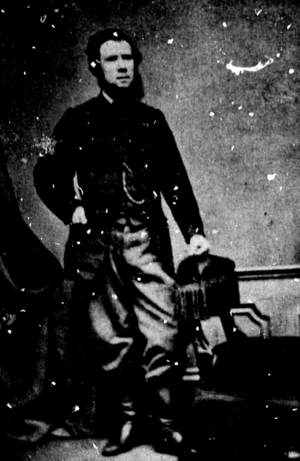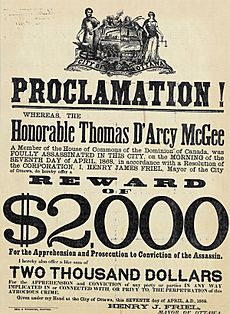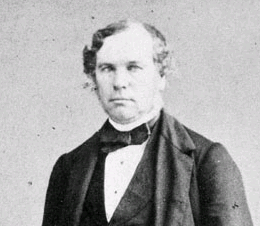Patrick J. Whelan facts for kids
Quick facts for kids
Patrick James Whelan
|
|
|---|---|
 |
|
| Born |
Patrick James Whelan
c. 1840 |
| Died | 11 February 1869 (aged 28–29) |
| Cause of death | Hanging |
| Nationality | Irish |
| Other names | Sullivan, Smith (alleged) |
| Occupation | Tailor |
| Motive | Fenian sympathy |
| Criminal charge | Murder |
Patrick James Whelan (around 1840 – 11 February 1869) was a tailor born in Ireland. He was thought to be a supporter of a group called the Fenians. Whelan was hanged after the killing of an Irish journalist and politician named Thomas D'Arcy McGee in 1868.
Whelan always said he was innocent. Many people still wonder if he was truly guilty. His trial had problems, like politics getting in the way and questions about witnesses.
Contents
Patrick Whelan's Life Story
Patrick Whelan was born around 1840 in County Galway, Ireland. He was one of the younger sons of William Whelan and Mary Sullivan. When he was about 14, he started learning to be a tailor.
His brother, John, was accused of setting fire to a police building in Tallaght, Ireland. After this, Patrick Whelan traveled a lot around England. He then moved to Canada around 1865.
In Quebec City, he worked as a tailor. He joined a group of volunteer soldiers to help defend the area from attacks by the Fenians. However, the military looked into him. They thought he might secretly support Irish independence fighters. He was arrested but later released without a military trial.
Whelan is believed to have lived in different cities, including Buffalo, New York, and Hamilton, Ontario. He finally settled in Montreal, Quebec, for a year. In 1867, he married Bridget Boyle. She was about 30 years older than him and came from a wealthy family. Later, the couple moved to Ottawa, where Whelan worked as a merchant tailor.
On December 31, 1867, two men visited McGee's home. One man, believed to be Whelan, warned McGee's family that people were planning to burn their house down. McGee's brother thanked him and gave him a note for the police. The note asked for officers to protect the house. However, Whelan did not deliver the note until the next morning, after the supposed arsonists had failed to show up. On March 17, 1868, Whelan helped organize the St. Patrick's Day Parade in Ottawa.
The Killing of Thomas D'Arcy McGee
In the early morning of April 7, 1868, Thomas D'Arcy McGee was returning to his boarding house on Sparks Street in Ottawa. As he was trying to unlock his door, the owner, Mary Ann Trotter, opened it for him. At that moment, a gun fired, and McGee was killed.
By the next evening, over 40 people were arrested. Most of them were Irish immigrants suspected of being Fenian supporters. One of the most important people arrested was Patrick Buckley. He worked for Prime Minister John A. Macdonald. Buckley told the police Whelan's name.
Police found Whelan in a tavern later that night. They searched him and found a small pistol in his pocket. It had all six bullets still inside. They also found a box of bullets, some papers, a newspaper, and membership cards for Irish societies. By April 9, 1868, 28-year-old Whelan was the main suspect. He was charged with McGee's murder.
Whelan's Trial and Execution
Patrick Whelan's trial lasted eight days and was quite unusual. The Prime Minister, who was a close friend of McGee, was allowed to sit next to the judge, William Buell Richards, during the trial. Interestingly, Whelan's lawyer, John Hillyard Cameron, was a Protestant. The prosecutor, James O'Reilly, was an Irish-Catholic.
On the first day of his trial, Whelan looked neat in a black suit and white vest. He seemed confident. He sat with his arms crossed, listening closely to everything. He even laughed when a police officer slipped. Agnes Macdonald, the Prime Minister's wife, wrote in her diary that Whelan was a "small, mean-looking" man who nervously stroked his mustache.
A 14-year-old servant named Eliza Tierney testified. She said she had known Whelan for six weeks and that he owned a pistol. However, she also said that another servant girl had accidentally fired the gun a week before McGee was killed. A bookkeeper named William Goulden confirmed this. He added that Whelan had offered to sell his pistol six weeks before the murder. Other evidence suggested Whelan owned the pistol because he enjoyed target shooting.
The prosecutor called Joseph Faulkner, a tailor who knew Whelan in Montreal. He hoped Faulkner would talk about Whelan's connections to the Fenians. Faulkner said Whelan seemed angry at McGee during an election. But other witnesses said Whelan was not interested in politics. Faulkner also said he knew nothing about Whelan being a Fenian. Another witness, Turner, claimed he heard a politician say the government offered someone named Doyle a lot of money to lie about Whelan. However, another witness, Susan Wheatley, later said she heard Turner himself say he would lie for money. Later, witnesses were directly asked if they had been paid for their testimony.
Now I am held to be a black assassin, and my blood runs cold. But I am innocent, I never took that man's blood.
There was laughter in the courtroom when Whelan's lawyer, Cameron, questioned a witness. Cameron thought he was talking to John Downey, but it was actually John O'Donnell. The judge had to correct him. Cameron then quickly excused the wrong witness.
In his closing speech, which lasted almost three hours, Cameron said he believed no one had ever had such an unfair trial. He gave examples of other cases where innocent people were found guilty and executed, only for the real criminal to be found later. The courtroom applauded when he finished. The prosecutor, O'Reilly, ended his speech by telling the jury not to imagine doubts where there were none. He said society expected them to deliver justice.
Verdict and Execution
On September 15, the jury found Whelan guilty. Judge Richards sentenced him to be hanged. When he heard the verdict, Whelan told the jury, "I am held to be a murderer. I am here standing on the brink of my grave, and I wish to declare to you and to my God that I am innocent, that I never committed this deed."
Whelan tried to appeal his case to a higher court. But Judge Richards, who had just been appointed to that court, cast the deciding vote not to change his own judgment. In January 1869, Whelan appealed again, but Richards was again on the court and voted against him. Whelan wrote a letter to a priest on February 1, 1869, saying his execution was coming soon and asking for the priest's help.
Patrick Whelan was publicly hanged on February 11, 1869, at the Carleton County Gaol. He faced his death bravely and with faith. He told the crowd that he was innocent, but he did know who killed McGee. His last words were "God save Ireland and God save my soul."
Legacy
Patrick James Whelan was apprehended, tried, and found guilty. He was probably only one out of a number of miscreants who conspired to commit the murder, but the whole truth respecting the dark affair has never been disclosed.
—Rene Doumic
Soon after Whelan's execution, the pistol he was accused of using was lost. It reappeared in 1973 as a family treasure belonging to Scott Renwick. In 2005, it was offered for sale at an auction for $55,000. The Canadian Museum of Civilization bought the gun for $105,000. It is now part of their collection.
Whelan's story is told in a play called Blood on the Moon by Pierre Brault, which came out in 1999. Brault's solo performance of the play was also made into a TV special.
Images for kids






